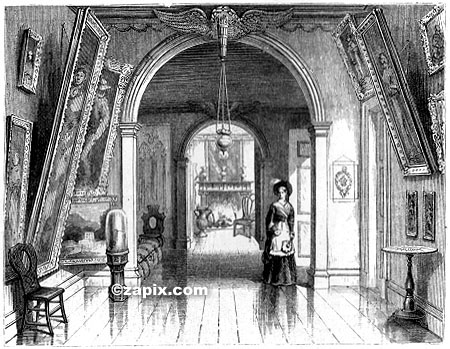|
|
The Romance of the Hudson, Part I, continued
 Hall of the Late Madame Jumel's Mansion.*
he understood it to be a legend. Not so. Her womanly sympathies were arouse by the recital of the fate of the trumpeter, and she inquired, "Did he leave a family?" The gentleman modestly referred her to the chronicle. That chronicle says: "Though he was never married, yet did he leave behind him some two or three dozen children in different parts of the country, tine, chubby, brawling, flatulent little urchins, from whom, if legends speak true (and they are not apt to lie), did descend the innumerable race of editors who people and defend the country, and who are bountifully paid by the people for keeping up a constant alarm and making them miserable."
From this point to the Highlands is spread out before the eye of the voyager the beautiful Hudson River front of Westchester County, its slopes dotted with growing villages linked by costly country-seat, and its lands in a state of highest cultivation. Between the Spuyt den Duyvel and the Croton was the famous "Neutral Ground," over which "Cow-boys" and "Skinners" — British and American bands of marauders — roved and plundered with impunity in Revolutionary times, until it became a very purgatory for the peaceful inhabitants. Over this domain marched and countermarched the Continental army. Here rested the French troops under Rochambeau, and here the loyalists carried on a distressing warfare while the British had possession of the city of New York. Here was the scene of the capture of André, which, perhaps saved the American cause from ruin. Almost every acre seen from the river by the voyager from Manhattan Island to Peekskill has been made classic to Americans by events of the old war for independence. A few miles north of Spuyt den Duyvel is the large village of Yonkers — Jonkheer — "young lord." It is really a child of the Hudson River Railway. Thirty years ago a church, a few indifferent houses, single sloop at small wharf, and the gray walls and roof of a venerable structure, which you may see stretching among the trees parallel with the river, composed the whole borough. That old building is the Philipse Manor-house, now occupied for municipal *The Morris or Jumel mansion contains at the present time the following articles: 1. A stand said to have belonged to Voltaire. 2. An elaborate embroidery of flowers, surrounded by a golden chain on a while ground, by the Empress Josephine. 3. A large black leather trunk with quaint steel bands, locks, handles, etc., believed by the family to have belonged to Napoleon I, and used by him on his journey to Moscow. The room at the end of the hail is furnished with articles once owned by General Moreau, and bought at the sale of his effects by Madame Jumel.
The hall contains many paintings, the last of a collection of one hundred and twenty-four once owned by the Jumels. There are also drawings and engravings of distinguished people who have been visitors at the house in years past — Aaron Burr, Napoleon III., Prince
Napoleon, Jerome Bonaparte, and Henry Clay. There is also a fine portrait of Napoleon I. The walls and wood-work of the hall are delicate blue, white, and gold, and the general effect is very striking when seen for the first time,
|
|
Page 8
Books & articles appearing here are modified adaptations
from a private collection of vintage books & magazines. Reproduction of these pages is prohibited without written permission. © Laurel O'Donnell, 1996-2006.
|
|

